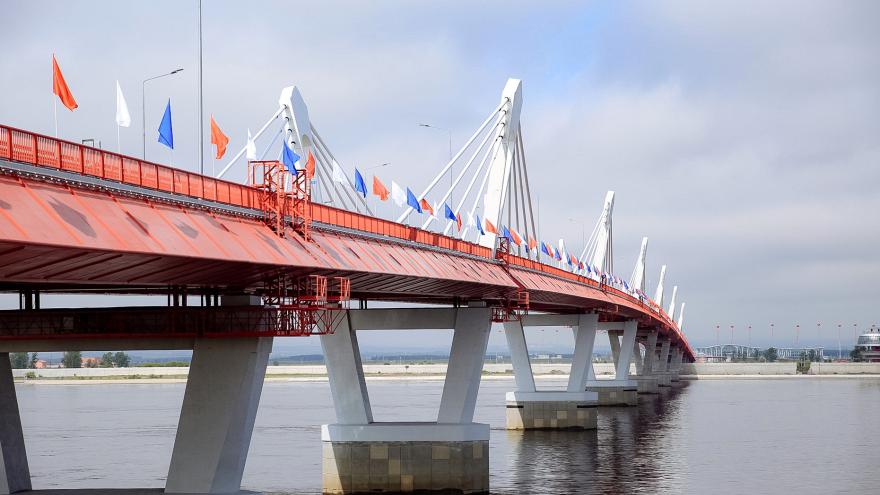China and Russia are building bridges. The symbolism is intentional

Now — as Russia’s economic isolation in the wake of its invasion of Ukraine pushes it closer to Beijing — that is changing, with fanfare. Last Friday, Beijing and Moscow feted the launch of another new link — what state media on both sides have called the first highway bridge over the Amur — with rockets trailing colorful smoke bursting overhead, and local officials applauding from the riverbanks, while their superiors beamed in from Moscow and Beijing on giant television screens specially brought in for the day. A second crossing, the only railway bridge to connect the countries across the river, is “Just recently Russia and China didn’t have a single bridge across the Amur River, but now they have as many as two bridges … so the trend is clear,” said Artyom Lukin, an associate professor of international relations at the Far Eastern Federal University in Vladivostok.But the bridges — each built in two halves, by the Chinese on one side and the Russians on the other — and the river they traverse also underline the uneasy foundations of that relationship.Known as the Amur in Russia and Heilongjiang in China, its riverbanks were once tense, heavily patrolled zones. An Amur tributary was the site of a 1969 border conflict, the result of ratcheting tensions between the Soviet Union and a young Communist China, and it wasn’t until the 1990s that territorial disputes were largely settled.Agreements at that time to develop the cooperation across the river stalled for years, as pontoons, hovercrafts and seasonal ice roads remained the means of ferrying people and goods across, while land and maritime connections elsewhere in the countries handled more trade. Previous routes weren’t sufficient, giving the rising volume of trade between Russia and China, according to Lukin.”China has always been pushing for more port infrastructure, but Russia was a bit reluctant until recently to build this kind of infrastructure, for fear of becoming too dependent on China,” Lukin said.”But now Russia has no choice,” he said, adding that since Russia’s annexation of Crimea in 2014 and the ensuing Western backlash, Russia has been “much more open” to Chinese initiatives to develop cross-border infrastructure.The highway bridge, in its original conception, was meant not just to enable the transit of goods, but to lead to new economic zones and passenger travel between the Chinese city of Heihe, home to around 1.3 million in its metropolitan area, and Blagoveshchensk, with a population of around a quarter-million.China’s Covid-19 policies may put that on hold for now, as the bridge will start only with freight, officials said. And even during Friday’s opening ceremony, the country’s now-infamous hazmat-clad workers were along the roadside welcoming the Russian freight trucks, a reminder of tight controls.But the prospect of even closer cross-border ties for Heihe and Blagoveshchensk, which had already flourished with tourism and trade before the pandemic, could usher in a new phase for the region. According to local media, the government has ordered all students in Blagoveshchensk to study Chinese from September 1.The opening may provide economic vitality for a “thinly populated” region of Russia, according to Yu Bin, a professor of political science at Ohio’s Wittenberg University and a senior fellow at the Russian Studies Center of the East China Normal University in Shanghai. It could also signal a shift away from the Russian “perception, or misperception” that such links could spark an influx of Chinese nationals into Russia’s Far Eastern regions, Yu said.There’s been scant evidence of such a trend, but those concerns have been linked to disparities between the two sides of the river. Heihe, part of Heilongjiang province with some 31 million people, over recent decades has grown into a bustling city with a colorful skyline that is reflected in the Amur River at Blagoveshchensk. Blagoveshchensk has seen slower growth and long experienced a population drain to western Russia, like the larger Far East region. The region makes up more than 40% of the country’s land, but its 8 million residents are only 5% of its population.However, “this time, Western sanctions against Russia seem to have helped alleviate these misperceptions and concerns about China’s potential immigration,” Yu said.On a national level the bridge — held up as a major diplomatic and economic win by Russian state media — also underlines a hanging question about how far Beijing will go to support Russia amid the international crisis it has provoked following its invasion of Ukraine.So far, China has walked a thin line. Beijing has said it upholds a rules-based world order, while refusing to join most of the world in condemning Moscow’s move and using its state media apparatus to mimic Kremlin lines blaming the United States and NATO for the crisis. It’s also boosted some imports from its heavily sanctioned neighbor, while appearing careful to avoid incurring any itself, treading carefully around high-tech exports that Western countries have widely blocked for export to Russia.”The first batch of cargo which crossed into China from Blagoveshchensk on the day of the official opening, soybean oil … underscores this role which Russia plays for China economically as a provider of natural resources and commodities,” said Far Eastern Federal University’s Lukin. “The more interesting question,” he said, “is what will be coming from China via this bridge?”







